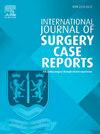Primary cardiac myxofibrosarcoma in a patient with Ebstein's anomaly: First reported case
IF 0.6
Q4 SURGERY
引用次数: 0
Abstract
Introduction
Primary Cardiac Myxofibrosarcoma (PCM) is a rare and aggressive cardiac malignancy, accounting for less than 1 % of primary cardiac tumors. It can occur infrequently with congenital heart defects like Ebstein's anomaly (EA), characterized by a malformed tricuspid valve. PCM often presents as a painless cardiac mass, leading to potential delays in diagnosis and treatment.
Presentation of case
We present the case of a 38-year-old female with a history of EA who presented with dyspnea. Echocardiography revealed severe tricuspid regurgitation and a mobile mass in the left atrium, which prolapsed through the mitral valve with each heartbeat. Intraoperative findings confirmed a lobulated mass. Histological analysis showed a multinodular spindle cell tumor within a myxoid stroma, featuring long, curvilinear blood vessels, few hypocellular myxomatous areas, and focal necrosis. Immunohistochemical staining revealed positivity for TLE1 and SMA, while the tumor was negative for AE1/AE3, S100, desmin, CD34, HMB45, and CD117, leading to a diagnosis of PCM.
Discussion
Initially suspected to be a myxoma, histopathological findings confirmed PCM, notably characterized by prominent thin-walled blood vessels. This highlights the importance of thorough pathological evaluation. This case is the first reported instance of PCM associated with EA, contributing to the limited literature on this rare combination.
Conclusion
Malignant tumors should be included in the differential diagnosis of cardiac masses. Prompt diagnosis and complete surgical resection are essential for improving patient outcomes and reducing the risk of recurrence.
埃布斯坦畸形患者的原发性心脏肌纤维肉瘤:首例报告病例
导言原发性心脏肌纤维肉瘤(PCM)是一种罕见的侵袭性心脏恶性肿瘤,占原发性心脏肿瘤的比例不到 1%。先天性心脏缺陷(如以三尖瓣畸形为特征的爱布斯坦氏畸形(EA))也会导致该病的发生,但这种情况并不多见。PCM 常表现为无痛性心脏肿块,可能导致诊断和治疗的延误。超声心动图显示左心房有严重的三尖瓣反流和移动性肿块,每次心跳时肿块都会脱出二尖瓣。术中检查结果证实这是一个分叶状肿块。组织学分析显示,肌基质内为多结节纺锤形细胞瘤,具有长而弯曲的血管、少量细胞减少的肌瘤区和灶性坏死。免疫组化染色显示 TLE1 和 SMA 阳性,而 AE1/AE3、S100、desmin、CD34、HMB45 和 CD117 阴性,因此诊断为 PCM。这凸显了彻底病理评估的重要性。本病例是首次报道 PCM 与 EA 相关的病例,为有关这种罕见组合的有限文献做出了贡献。及时诊断和彻底手术切除对改善患者预后和降低复发风险至关重要。
本文章由计算机程序翻译,如有差异,请以英文原文为准。
求助全文
约1分钟内获得全文
求助全文
来源期刊
CiteScore
1.10
自引率
0.00%
发文量
1116
审稿时长
46 days

 求助内容:
求助内容: 应助结果提醒方式:
应助结果提醒方式:


